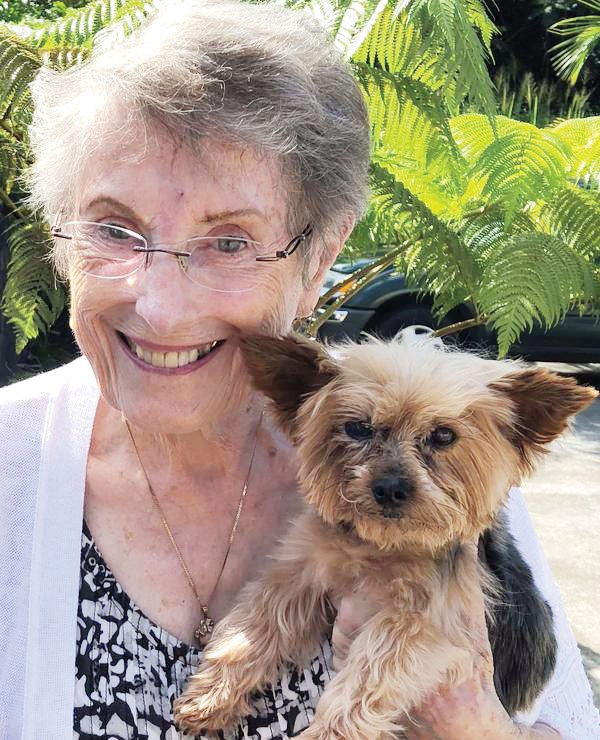Moving to the Hawaiian Islands with pets is no easy task because of the rabies laws. No arriving cat or dog, regardless of age, is exempt.
Each pet has a mountain of paper work, a fee, and a paws-ible quarantine of 120 days because Hawaii does not have rabies, or want it. Yet, they do have Kilauea Volcano.
Despite the proximity to lava, 89-year-old dog owner Pat moved to Hawaii’s Big Island in Pahoa after being encouraged by daughters Vickie and Debbie. Pat submitted the pet paperwork, sold her home, shipped her household goods to Hawaii, and flew with her 10-year-old pets, Penny the blind Yorkie, and two Siamese cats, Chip and Dale, to their new home in Pahoa.
A month later, multiple earthquakes woke her up, then to top things off, Kilauea blew its top. Pat felt safe because, “Lava flows downhill and I lived up hill from it at Leilani Estates.”
So, she was not prepared to evacuate.
Then #8 fissure blew open on her street and everything changed! Vickie sped to her rescue and as they were putting pets in carriers a police officer arrived and urgently announced, “Evacuate! Now!”
They fled to Vickie’s home with Pat’s pets. In their panic, clothes, medicine, family photos, important papers and valuables were left behind in the flight to save their lives.
Two days later, the fissure’s heat set Pat’s new home on fire, then lava encased the ruins in ten feet of black hardened rock.
Two days after that, Vickie’s home was circled by lava forcing them to evacuate.
A day later, Debbie also had to abandon her home because of toxic volcanic gases. All three families and their pets scrambled to find places to live.
Today, Pat is living with a total stranger, Paula, and her three dogs. Paula opened her home to Pat and their friendship blossomed like “long-lost friends,” so Paula said Pat could stay with her indefinitely.
Penny loves her three new dog pals, and Chip and Dale are adjusting to being sequestered in Pat’s bedroom.
“There’s nothing I can do about what has happened,” said Pat. “There’s no telling when the volcano will go dormant. I am numb and don’t cry. I’m grateful that I have my animals, we are safe, and we have a place to stay where we are welcomed.
“Yesterday after a doctor’s appointment I went to a restaurant. My teenager server said, ‘I know that you lost everything, so I paid for your meal.’ Through all this turmoil, I have learned how kind people are.”
Everyone should have a list on hand in case of a natural disaster. Once you learn you have to evacuate, panic mode stops normal thinking. Those with pets need to paw-pare extras.
-List things needed for two weeks and keep with the pets carriers: Documents, photographs, human/pet food, kitty litter, puppy pads, medical supplies in case of a pet emergency, cleanup products for carsick animals, and harnesses for cats because you can’t leave them in carriers for days on end.
- Have a carrier for each pet, their vet records, toys, towel, favourite blanket, and a photo of each animal in case one escapes. Have them microchipped.
- Put extra leashes, collars, food bowls, and pet food with the carriers to grab at a moment’s notice because not everyone is given a day to prepare. Some families, like Pat, only have minutes
- During floods, bungee cord pet cages to flotation devices like swimming kick boards or a cooler.
Christine Ballantine, founder of the Western Canada Pekingese Club said, “I always have an under-seat airline bag packed, for my Pekingese, in case of emergency. The bag contains: ziplock bag with a week of dry kibble, favourite treats, food/water dishes, water bottles, two leashes, paper towels, poop bags, grooming brush and a pet first aid kit.”
Retired fire chief, Dan Olsen, adds, “We also have a bottle of hydrogen peroxide (for cuts and scratches), duct tape (for emergency repairs), paper towel rolls and toilet paper. We use a “grab and go” backpack for pet and people essentials, and a small cooler and five gallon bucket (with lid) in the car with supplies.”
The Federal Emergency Management pet webpage is at fema.gov/helping-pets.



